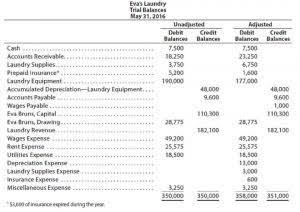
It allows for the proper recognition of the parent company’s control over its subsidiaries, which is crucial for accurate financial reporting and analysis. Consolidated financial statements are crucial for presenting the financial position and performance of a parent company and its subsidiaries as a single economic entity. The preparation involves combining the financial statements of the parent company with those of its subsidiaries, eliminating intercompany transactions and balances to avoid double counting. This process ensures that stakeholders receive a clear and accurate picture of the group’s overall financial health. A consolidated financial statement is a group of financial statements of a parent company and its divisions and/or subsidiaries. Consolidated financial statements present the assets, liabilities, income, revenue, expenses, and cash flows of these entities as a single entity.
- It allows them to capitalize on existing strengths while eliminating redundancies or wasteful practices.
- Consolidated financial statements include the aggregated financial data for a parent company and its subsidiaries.
- Creating consolidated financial statements can be a complex and time-consuming task.
- This method allows management to gain insight into the entire organization from a single source rather than through multiple accounts from different departments or locations.
- In a MTQ it is likely you would be given the value of a NCI share and have to apply it to the 8,000 shares that Red Co did not acquire.
Equity Adjustments
If a public company wants to change from consolidated to unconsolidated, it may need to file a change request. Switching may also raise concerns with investors or usher in complications with auditors, so filing consolidated subsidiary financial statements is usually a long-term financial accounting decision. There are, however, some situations where a corporate structure change may call for a changing of consolidated financials, such as a spinoff or acquisition. Consolidation accounting is used when a parent company owns a controlling financial interest in one or more subsidiary companies. In Microsoft’s FY25 Q2 financial disclosures, the company reported returning $9.7 billion to shareholders through dividends and share repurchases during the quarter.
Consolidating does not mean merging entities.
In this question, $5,000 of sales have been made from Purple Co selling to Silver Co. This must be eliminated, irrespective of whether the items remain unsold at the year end. This is because the consolidated statement of profit or loss needs to show revenue and cost of sales which consolidated account meaning reflect group performance with external, non-group, entities only. Consolidation accounting is a method of accounting used when a parent company owns subsidiaries (from 20% to upward of 50%).

Why is consolidation necessary in accounting?

The purpose of consolidation is to present information about the performance and position of all companies within the parent company’s economic environment as one monetary unit. It allows investors to understand better how well the parent company manages all its subsidiaries together rather than viewing them separately. Another significant challenge is the elimination of intercompany transactions and balances. These transactions can distort the financial health of the consolidated entity if not properly adjusted. Best practices include implementing robust intercompany reconciliation processes and leveraging advanced software solutions to automate and streamline Online Accounting these adjustments. Existing investments between the parent and its subsidiaries must be addressed to prevent double-counting.
- The consolidation process can be time-consuming and complex, especially for organizations with multiple subsidiaries or complex ownership structures.
- By consolidating financial statements, companies can streamline their accounting operations by reducing the time needed for manual processes and eliminating duplicate data entry.
- Both GAAP and IFRS have distinct guidelines for entities reporting consolidated financial statements with subsidiaries.
- While the above is not a complete list of all the consolidation rules in accounting, this comprehensive list is a good place to get started.
- Consolidated account statement gives an investor all the details of his or her mutual fund transactions in an orderly manner at a single place.
- Always start by reading the question requirement carefully to determine what is being asked for.
- The final financial reporting statements remain the same in the balance sheet, income statement, and cash flow statement.
Not all subsidiaries must be consolidated.

The consolidated balance sheet shows the assets, liabilities and shareholders’ equity across company A, company B and company C. If Company A has assets worth £1,000,000, Company B has assets worth £300,000 and Company C has assets worth £500,000, the consolidated balance sheet shows assets worth £1,800,000. In the accounting of company A, one must now look at the annual financial statements of companies B and C and, if necessary, offset items against each other or remove them from the annual financial statements. Consolidation is the bringing together of all financial statements of affiliated companies within a group.
- This transfers the debt owed from multiple creditors, allowing the consumer to have a single point of payment to pay down the total.
- This comprehensive overview presents the financial position and results of operations of a group as if it were a single economic entity.
- Under GAAP, if a parent company owns more than 50% of another company’s voting stock, it must consolidate the subsidiary; however, under IFRS, this threshold can vary between 20-50%.
- It originates from the Latin ” consolidatus ” meaning “made solid.” This practice can combine companies in a merger or acquisition and restructure debt by paying off one loan with another.
More than just joining together, consolidation in accounting is a list of precise processes fundamentally rooted in accounting’s best practices. If the parent company does not own 100% of shares of the subsidiary company, there is a proportion of the net assets owned by an external shareholder. This proportion that is related to outside investors is called the minority interest or non-controlling interest (NCI). The consolidation process can be time-consuming and complex, especially for organizations with multiple subsidiaries or complex ownership structures. It requires careful analysis, adjustments, and eliminations to ensure accurate and meaningful financial reporting. For instance, if a company owns less than 20% of another company’s stock, it will usually use the cost method of financial reporting.

Simplify your consolidation process with powerful financial solutions.
The consolidated financial statement should reflect the combined equity investments, liabilities and net worth of all entities included in the consolidation Accounts Payable Management process. Finally, accountants must ensure that reported revenues or expenses are not double-counted when completing this task. It should address the necessary steps to prepare consolidated financial statements, including compiling subsidiary accounts into a parent company’s financial statements.